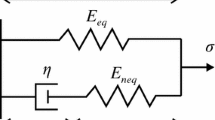Abstract
A general framework for developing nonlinear hyperelastic/plastic constitutive laws for anisotropic solids experiencing large strains and strain rates has been developed. The proposed framework does not rely on the “a priori” known strain energy function, but instead introduces a physical decomposition of the material element into seven physically independent stress bearing mechanisms, each of which has a constitutive law in terms of internal moments described by a scalar function of a single variable. The model has been encoded into a combined finite-discrete element method and tested against static geomechanical test data. The numerical validation experiments show the model can reproduce plastic anisotropic behaviour in both biaxial and uniaxial loading of a geomaterial.






(modified from [11])

(modified from [12])

(according to [13])















Similar content being viewed by others
References
Munjiza A (2004) The combined finite-discrete element method. Wiley, London
Munjiza A, Knight EE, Rougier E (2011) Computational mechanics of discontinua. Wiley, London
Munjiza A, Rougier E, Knight EE (2015) Large strain finite element method: a practical course. Wiley, London
Atluri SN (1984) On constitutive relations at finite strain: hypo-elasticity and elasto-plasticity with isotropic or kinematic hardening. Comput Methods Appl Mech Eng 43(2):137–171
Roy S, Fossum AF, Dexter RJ (1992) On the use of polar decomposition in the integration of hypoelastic constitutive laws. Int J Eng Sci 30(2):119–133
Bazant ZP, Vorel J (2013) Energy-conservation error due to use of Green–Naghdi objective stress rate in commercial finite-element codes and its compensation. J Appl Mech 81(2):021008
Simo JC, Ortiz M (1985) A unified approach to finite deformation elastoplastic analysis based on the use of hyperelastic constitutive equations. Comput Methods Appl Mech Eng 49:221–245
Lei Z, Rougier E, Knight EE, Munjiza A, Viswanathan H (2016) A generalized anisotropic deformation formulation for geomaterials. Comput Part Mech 3(2):215–228
Rougier E, Munjiza A, Lei Z, Chau VT, Knight EE, Hunter A, Srinivasan G (2019) The combined plastic and discrete fracture deformation framework for finite-discrete element methods. Int J Numer Methods Eng. https://doi.org/10.1002/nme.6255
Lei Z, Rougier E, Knight EE, Frash L, Carey JW, Viswanathan H (2016) A non-locking composite tetrahedron element for the combined finite discrete element method. Eng Comput 33(7):1929–1956
The Engineering ToolBox. Temperature and strength of metal. https://www.engineeringtoolbox.com/metal-temperature-strength-d_1353.html. Accessed 2 Jan 2020
Grote DL, Park SW, Zhou M (2001) Dynamic behavior of concrete at high strain rates and pressures: I. Experimental characterization. Int J Impact Eng 25(9):869–886
Kerr SA, Cotter DM, Yarrington PA, Kipp M, Groethe M, Gran J. Single burst and multi burst test results. Sandia Report 2000
Zhang H, Wan J, Ma D, Zhang Y, Cheng J, Zhang Q (2017) Experimental investigation on the strength and failure behavior of coal and synthetic materials under plane-strain biaxial compression. Energies 10:500
Kupfer H, Hilsdorf HK, Rusch H (1969) Behavior of concrete under biaxial stresses. ACI J 66(8):656–666
Yin WS, Su ECM, Mansur MA, Hsu TTC (1989) Biaxial tests of plain and fiber concrete. ACI Mater J 86(3):236–243
Gurtin ME (1981) An introduction to continuum mechanics. Academic Press, Cambridge
Acknowledgements
The work reported in this paper was funded by the Source Physics Experiment. The Source Physics Experiments (SPE) would not have been possible without the support of many people from several organizations. The authors wish to express their gratitude to the National Nuclear Security Administration, Defense Nuclear Nonproliferation Research and Development (DNN R&D), and the SPE working group, a multi-institutional and interdisciplinary group of scientists and engineers. This work was done by Los Alamos National Laboratory under award number DE-AC52-06NA25946. We would also like to acknowledge the Los Alamos National Laboratory LDRD Program (#20170109ER). This research used resources provided by the Los Alamos National Laboratory Institutional Computing Program, which is supported by the U.S. Department of Energy National Nuclear Security Administration under Contract No. 89233218CNA000001.
Funding
The funding was provided by U.S. DOE’s NNSA Award No. DE-AC52-06NA25946; Los Alamos National Laboratory, LDRD Program Award No. 20170109ER; Los Alamos National Laboratory, Institutional Computing program.
Author information
Authors and Affiliations
Corresponding author
Ethics declarations
Conflict of interest
On behalf of all authors, the corresponding author states that there is no conflict of interest.
Additional information
Publisher's Note
Springer Nature remains neutral with regard to jurisdictional claims in published maps and institutional affiliations.
Rights and permissions
About this article
Cite this article
Lei, Z., Bradley, C.R., Munjiza, A. et al. A novel framework for elastoplastic behaviour of anisotropic solids. Comp. Part. Mech. 7, 823–838 (2020). https://doi.org/10.1007/s40571-020-00345-2
Received:
Revised:
Accepted:
Published:
Issue Date:
DOI: https://doi.org/10.1007/s40571-020-00345-2




